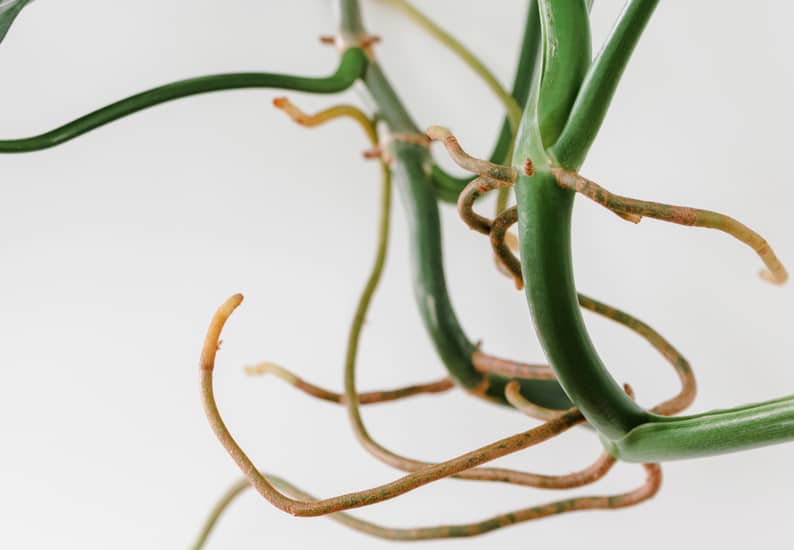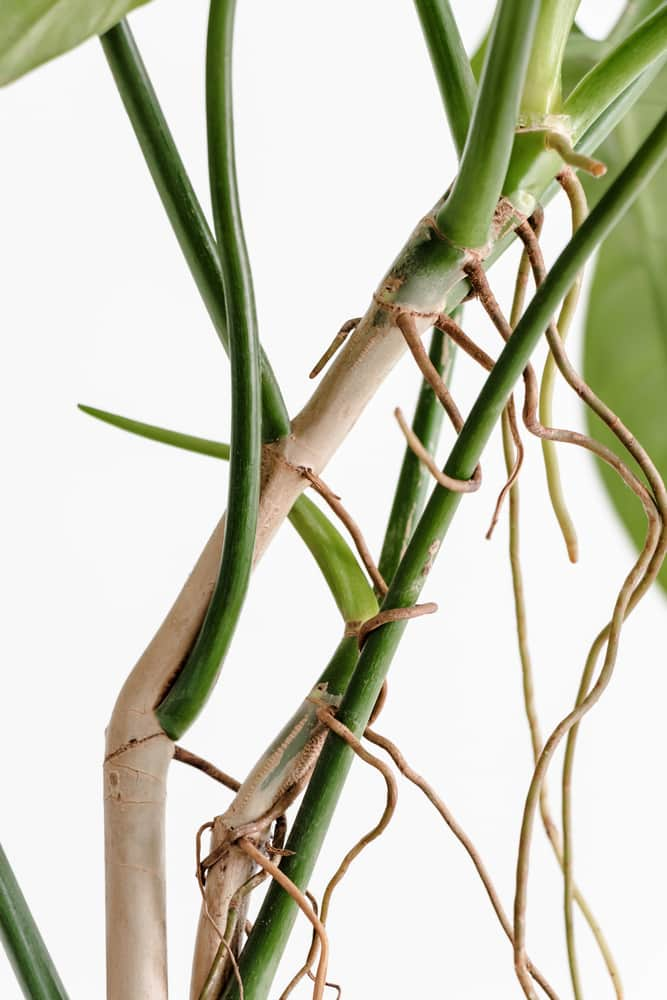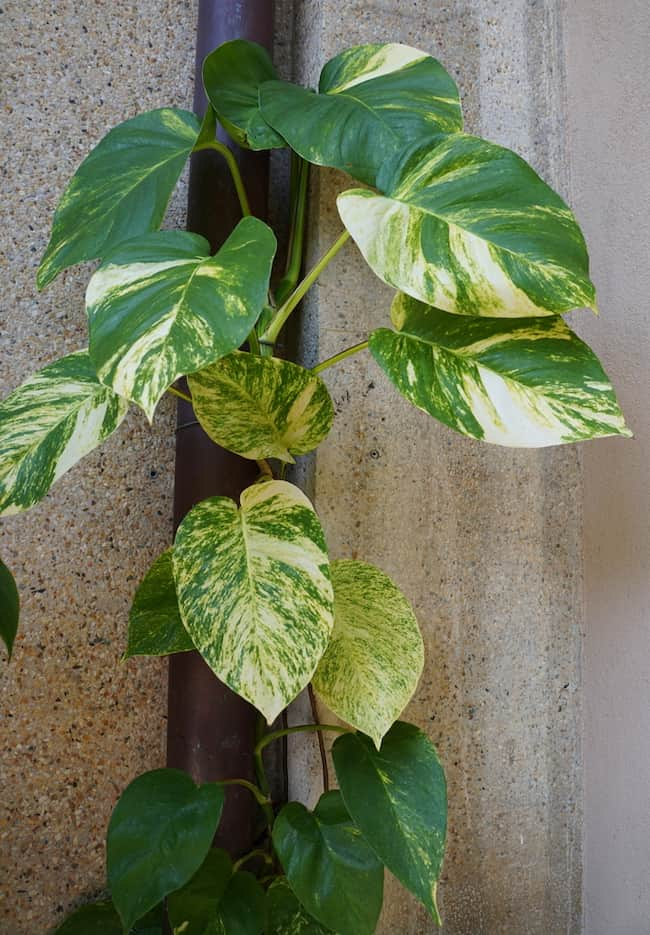In the wild, Pothos (Epipremnum aureum) aerial roots cling onto the bark of trees so they can climb upward in a quest for water and nutrients. But, what do you do about aerial roots when your Pothos is growing in the house or in your container garden?
My golden Pothos’ aerial roots climb up a moss pole that I inserted into the potting soil. It pretty much makes its own decisions now about how it wants to grow.
It’s getting tall and spreading out now, practically taking over my patio, so it’s pretty clear that it’s time to take control of the aerial roots soon. I just have to decide which method I want to use.
If you’re in the same situation, there are several things you can do with aerial roots on Pothos to keep the plant healthy and under control. And even better: these methods also work with other houseplants with aerial roots!

Table of Contents
What to do with pothos aerial roots?
You can leave aerial roots the way they are, letting them grow outside the pot. You can also prune back the aerial roots, especially the dry ones. Another option is to take the end of the aerial root and bury it back in the soil.
If you decide you want to leave the aerial roots on Pothos, I recommend that you trim off the dried and hollow ones. This will encourage the remaining roots and any new ones to climb up a trellis or pole.
Perhaps you don’t like the looks of aerial roots curling around your plant. In that case, feel free to prune them close to the main stem. It won’t hurt your plant.
Find out more: 6 Simple Steps to Prune Your Pothos (Ultimate Guide)
Can I plant pothos with its aerial roots?
Yes, you can plant Pothos with its aerial roots in soil. Just place the roots in the pot and cover them with potting mix. They will begin growing their own roots, which helps stabilize the plant. Another method is to put the aerial roots in water and let them grow roots before planting.
If the aerial roots are too long, or there are too many to fit in the pot, you can trim them back. They’ll continue to grow after you plant them.
Don’t worry about planting aerial roots. Many people gently turn the Pothos aerial roots back into the soil. If you have a large web of roots, transplant the whole plant, aerial roots, and all into a larger pot.
Keep in mind: You can’t propagate pothos from aerial roots alone. If the aerial roots are attached to a cutting with at least one node, then it will work, but aerial roots themselves don’t have any nodes that allow for growth.
Can you cut the aerial roots off a pothos?
There is no harm in cutting aerial roots off a Pothos, although the only ones you actually need to remove are dead ones, since they don’t provide nourishment to the plant. Also, if you notice a broken aerial root, you can trim it off. But, even damaged ones will deliver water if the middle of the root is intact.
Aerial roots provide water and nutrients to Pothos. They also offer stability to the plant, and so they help to prevent it from toppling over. As long as the aerial roots aren’t rotten or completely hollow, they continue growing.
If you decide to trim your Pothos aerial roots because they are growing on your wall or across the floor, make sure you sterilize the shears. Either pour boiling water over them or rub hydrogen peroxide on the blades.
Using non-sanitized gardening shears runs the risk of introducing bacteria and diseases to your Pothos.
Overall, it’s okay to cut the aerial roots off a Pothos, but not necessary. Some horticulturists believe that Pothos need aerial roots to grow large leaves. This is only from observation rather than scientifically proven.
Will my pothos aerial roots grow back?
Yes, absolutely. If you cut an aerial root off a Pothos, it will grow back quickly since their job is to climb upward toward more light and absorb water and nutrients for the plant. When they start growing back, you’ll notice small nubs appearing on the Pothos stems.
Sometimes, the roots don’t get any bigger than nubs unless you give them a plant pole to attach themselves to.

Should I put pothos aerial roots in water?
You don’t have to put your pothos’ aerial roots in water because they absorb water from the air. You can put them in water along with the stem if you want to propagate them, but they don’t need water to survive. If you do put them in water, change the water every few days and check them for root rot.
When propagating your aerial roots on Pothos, cut a piece of the aerial root that’s connected to a stem node, along with three leaves. Put them in a jar of water. Just imagine rooting another gorgeous Pothos houseplant yourself.
Pothos aerial roots propagation is fun and easy. Even if you’ve never propagated a plant before, you’ll have success with this method. This method also works with stem cuttings.
- Place the end of the aerial root and stem node in a jar of water.
- Change the water every three days.
- Wash the jar if you see green algae.
- Aerial roots sprout in one to two weeks.
When you see the roots forming on the Pothos aerial root, transplant it into another pot. Another option is to just let another plant grow right from the aerial root.
This is a super effective way to propagate a bunch of baby Pothos. In fact, some people fill entire rooms with Pothos plants grown from aerial roots!
You may also be interested: 5 Easy Steps to Transfer a Propagated Pothos from Water to Soil
What do pothos aerial roots look like?
Pothos aerial roots look like long, quite solid tentacles. In nature, they attach to the bark of trees and climb toward the light. They start out green, and eventually pothos aerial roots turn brown and develop a tough outer layer.
When aerial roots start forming on your Pothos, you’ll see little thick nubs sprouting from the pothos nodes on the stems. These grow into long tendrils that climb up poles or anything they attach to. Some aerial roots also grow downward, across the floor.
When your Pothos needs water, the aerial roots turn gray. You might think they’re dying, but they still absorb water from the atmosphere. Dead aerial roots are dry, brown, and hollow.

Why are my pothos aerial roots fuzzy?
Usually, Pothos aerial roots become fuzzy when they’re overwatered or sitting in water. Root hairs start growing from the aerial roots, which appear fuzzy. This is normal, especially when you’re rooting the aerial roots. The fuzz helps the root absorb nutrients and water. However, this can also sometimes be a sign of fungus or mold.
If you notice any leaves on your Pothos with black around the edges, it’s a sign that the fuzz is probably a fungus due to the soil being too wet. Overly wet soil stimulates fungus growth, which is partly why your Pothos needs drainage.
If fungus is the case, remove your Pothos from the pot. Repot it with new soil (here’s my pick for the best soil for Pothos plants) and place it in a room with bright light. Your Pothos should spring right back. They’re very hardy.
You may also be interested in: 7 Simple Steps to Repot Pothos Plants
Why are my pothos aerial roots drying out?
Pothos aerial roots dry out when they’re not getting enough water or humidity. This causes them to become dehydrated. They can’t absorb water or nutrients once they’re dehydrated. Other visual clues of dehydration are dry soil and shriveled and sunken Pothos leaves.
When Pothos aerial roots dry out, start a watering schedule. Water every four to five days during warm weather, or every seven to eight days during cold weather. The tip of the aerial root should turn green again once it’s hydrated.
Want to know more about how often to water your pothos? Take a look here!
Be careful not to overwater pothos, because that can cause root rot. Also, make sure your Pothos isn’t located near a heater or in direct sunlight.
Other possible reasons for dry aerial roots are coldness, and burning from fertilizers or tap water that has too much salt and minerals. If this is the reason, the roots will appear brown and the soil will show a white crust.
Will aerial roots help my pothos climb?
Yes, aerial roots are the reason your Pothos can climb. Aerial roots evolved to attach themselves to tree bark, so they could climb higher. They do this to reach sunlight and water. Pothos need them to climb up any pole or structure.
It’s easy to train your Pothos to climb whether it’s indoors or outside. All you need is something the aerial roots can anchor themselves to, such as a moss pole, trellis, bamboo pole, or a wall. If it’s outside, even a tree or stone wall is fine.

Once you have an anchored support, loosely tie the aerial root to the support. Since the root has something to grab, it will naturally climb up the supporting structure or pole.
For faster climbing, place a light above the Pothos. This encourages the aerial roots to reach for the lighting as your pothos strives to meet its light needs.
What is the best support for pothos aerial roots to climb?
Even though aerial roots climb on anything they can reach, training them to climb a moss pole is the most beneficial option for your Pothos. THis is because, as the aerial roots climb, they absorb additional nutrients from the moss.
A moss pole for your pothos is perfect for supplying aerial roots with water. Just mist the moss, and the roots absorb the water. Misting also prevents overwatering, which can result in root rot in your pothos.
Will pothos aerial roots ruin my walls?
If you’re thinking about creating a living wall with your Pothos, but you’re worried about ruining your walls, it’s not really a problem. Aerial roots won’t attach to walls by themselves. You have to give them something to help them climb, such as hooks, shelving, or picture hangers.
Another idea is to attach a lattice to the wall and let the aerial roots anchor themselves to its surface.
If your Pothos aerial roots do attach to your walls, they won’t embed into the surface. The aerial roots aren’t strong enough to do that. But take note that, when you remove the Pothos, residue from the roots can stain the wall’s paint.
Check the aerial roots as they grow. If you notice them leaving residue, you can redirect them to a climbing pole or other structure.
Why do pothos grow aerial roots?
Pothos grow aerial roots so they can climb. In its native tropical habitat, the aerial roots grow along the Pothos stems and attach themselves to trees. As the roots climb, the Pothos plant grows.
In fact, unlike the potted houseplant you have, wild Pothos aerial roots grow fast. When Pothos live outside, they climb to the tops of trees and the vines spread across their upper limbs, forming a large canopy.

This is actually an environmental danger because the 18-inch leaves block the sun from the vegetation below.
You don’t have to worry about monster Pothos with a potted indoor plant. Most Pothos houseplants are juveniles and only grow as tall as their support.
Related: How Fast Does Pothos Grow (and How to Make it Grow Faster)?
How do aerial roots help pothos plants?
Aerial roots help Pothos in several ways. Not only do they provide additional water and nutrients to the plant, but they also help stabilize the Pothos. By anchoring themselves to poles or trellises, they keep the growing roots from pulling out of the soil.
Pothos aerial roots also provide oxygen to the plant. This is one of the reasons the aerial roots climb up trees in tropical forests. They reach up out of the soggy ground and absorb oxygen.
Why doesn’t my pothos have aerial roots?
Your Pothos likely doesn’t have aerial roots because you aren’t encouraging it to climb, meaning it doesn’t need to use its aerial roots the way it would in its natural habitat. There’s no need to worry though as a lack of aerial roots doesn’t mean there’s a problem with your Pothos.
In nature, aerial roots grow because of the damp, humid habitat. The roots either crawl along the rainforest floor or head up into the trees.
When you pot Pathos, the aerial roots lose their purpose of climbing toward the light. In fact, this is why you see many house plants with aerial roots in their natural habitats not actually growing them anymore in people’s homes.
If you want aerial roots, tie your Pothos to a moss pole. Most likely, you’ll notice aerial root nubs developing within a week or so. Keeping the moss pole damp will encourage aerial roots to continue growing.
